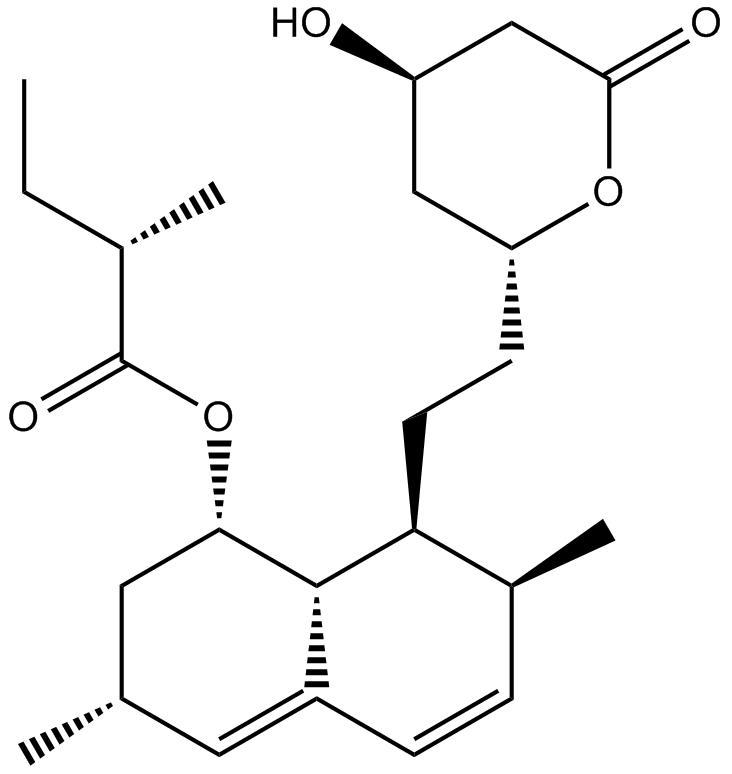Lovastatin (Synonyms: (+)-Mevinolin, Monacolin K, NSC 633781) |
| Catalog No.GC11633 |
An inhibitor of HMG-CoA reductase
Products are for research use only. Not for human use. We do not sell to patients.

Cas No.: 75330-75-5
Sample solution is provided at 25 µL, 10mM.
Lovastatin is an inhibitor of 3-hydroxy-3-methyl-glutaryl-CoA (HMG-CoA) reductase with IC50 values of 2.3 nmol/L in rat liver cells and 5 nmol/L in the human liver hepatocellular carcinoma cell line, HepG2 [1].
HMG-CoA reductase is responsible for the catalysis of the rate-limiting step in the biosynthesis of cholesterol. It catalyzes the conversion of HMG-CoA to mevalonate, the second step in the production of cholesterol in cells [2].
Lovastatin prevented the proliferation of several cell types by inhibiting the production of mevalonate and its metabolites. Inhibition of mevalonate formation also prevented the production of isoprenoids which are necessary for cell proliferation and other important cell functions. This reduction in isoprenoids caused beneficial pleiotropic effects. Lovastatin caused reduction in DNA synthesis at concentrations of 1 to 20 µM. At 1 µM, it inhibited the increase of mesangial cells in culture. Lovastatin (5 μM) also increased efferocytosis (phagocytosis of apoptotic cells) after 6 hours. However, after 24 hours, its effect was dose-dependent, with a maximum at 10 µM [3, 4, 5].
Mice treated with lovastatin (10 mg/kg) three times over 30 hours showed increased efferocytosis by alveolar macrophages. In a guinea pig wound chamber model, lovastatin (5 µM, 8 days) decreased granulation tissue formation by 64.7% [5, 6].
References:
[1]. Amin D, Gustafson SK, Weinacht JM, et al. RG 12561 (Dalvastatin): A novel synthetic inhibitor of HMG-CoA reductase and cholesterol-lowering agent. Pharmacology, 1993, 46(1): 13-22.
[2]. Tobert JA. Lovastatin and beyond: the history of the HMG-CoA reductase inhibitors. Nature Reviews Drug Discovery, 2003, 2(7): 517-526.
[3]. Massy ZA, Keane WF, Kasiske BL. Inhibition of the mevalonate pathway: benefits beyond cholesterol reduction. The Lancet, 1996, 347(8994): 102-103.
[4]. O'Donnell MP, Kasiske BL, Kim Y, et al. Lovastatin inhibits proliferation of rat mesangial cells. Journal of Clinical Investigation, 1993, 91(1): 83.
[5]. Morimoto K, Janssen WJ, Fessler MB, et al. Lovastatin enhances clearance of apoptotic cells (efferocytosis) with implications for chronic obstructive pulmonary disease. The Journal of Immunology, 2006, 176(12): 7657-7665.
[6]. Tan A, Levrey H, Dahm C, et al. Lovastatin induces fibroblast apoptosis in vitro and in vivo: a possible therapy for fibroproliferative disorders. American journal of respiratory and critical care medicine, 1999, 159(1): 220-227.
Average Rating: 5 (Based on Reviews and 30 reference(s) in Google Scholar.)
GLPBIO products are for RESEARCH USE ONLY. Please make sure your review or question is research based.
Required fields are marked with *




